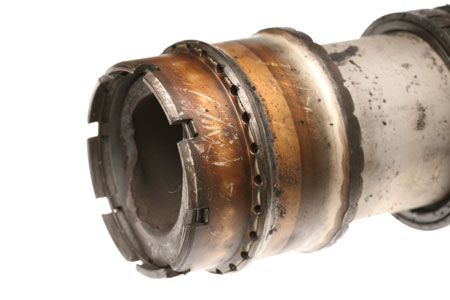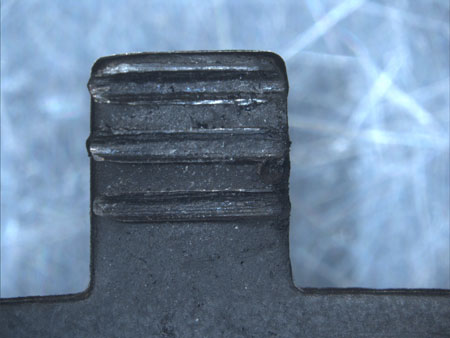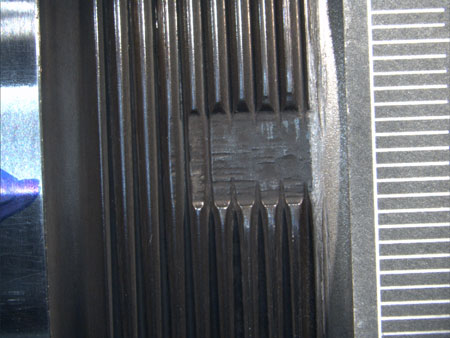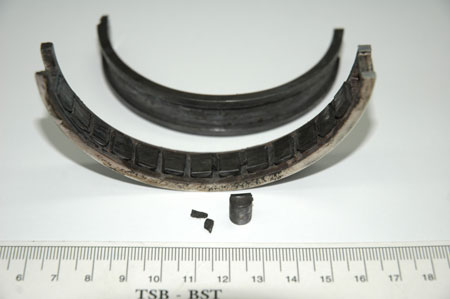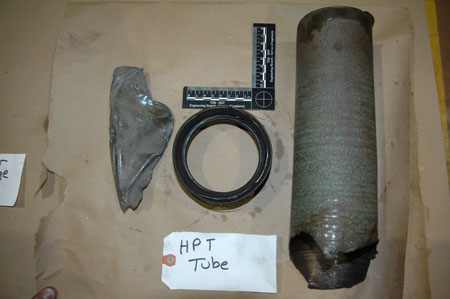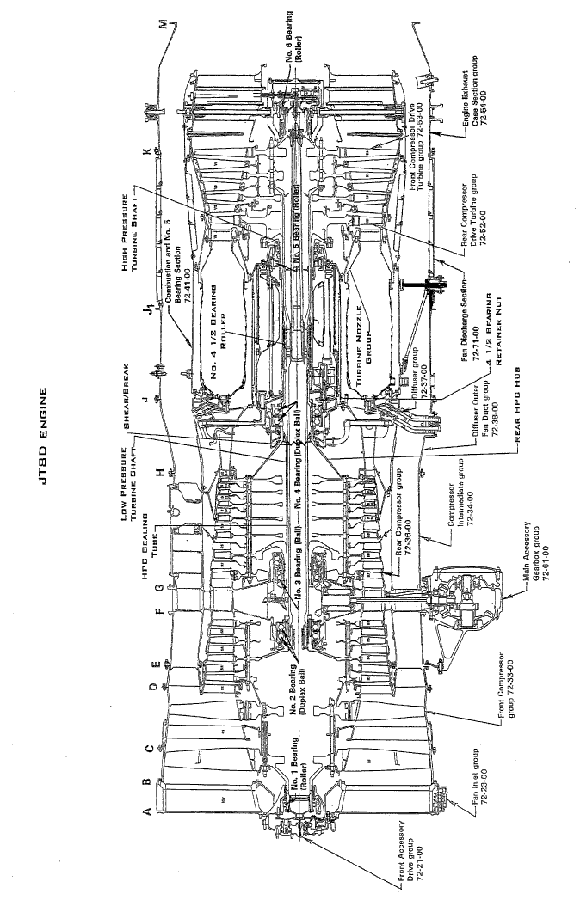Engine Power Loss
Canadian North Inc.
Boeing 737-217, C-GKCP
Saskatoon, Saskatchewan
The Transportation Safety Board of Canada (TSB) investigated this occurrence for the purpose of advancing transportation safety. It is not the function of the Board to assign fault or determine civil or criminal liability. This report is not created for use in the context of legal, disciplinary or other proceedings. See Ownership and use of content. Masculine pronouns and position titles may be used to signify all genders to comply with the Canadian Transportation Accident Investigation and Safety Board Act (S.C. 1989, c. 3).
Summary
Canadian North Inc. flight MPE1714, a Boeing 737-217 (registration C-GKCP, serial number 22729), was en route from Fort MacKay, Alberta, to Saskatoon, Saskatchewan. On final approach to Runway 15, there was a high-pitched noise and a vibration from the right engine followed by two short popping sounds, after which the right engine (a Pratt & Whitney JT8D 17A) lost power. The crew carried out the checklist items for an engine failure and declared an emergency. The aircraft then landed and came to a stop on Runway 15. Both engines were shut down and a fire in the right engine was extinguished by the Saskatoon Airport Aircraft Rescue and Fire Fighting service. The crew and passengers carried out a rapid evacuation of the aircraft via the forward (L1) air stairs without injury. The incident occurred during hours of darkness at 0120 central standard time.
Factual information
The first officer was the pilot flying. The aircraft was at about 1000 feet above ground level (agl), and 5 nautical miles (nm) from the runway on final approach when the engine power loss occurred. Upon recognition of the emergency, the captain took control of the aircraft and reconfigured the flaps to 15 degrees. Canadian North Inc's (Canadian North's) standard operating procedures require the flaps to be set at 15 degrees when performing a single-engine landing. Sparks and flames were emitted from the rear of the engine; however, there was no cockpit indication of an engine fire and the fire bottles were not discharged. After the aircraft came to a stop on the runway, the airport firefighters approached the right engine and noticed flames inside the engine exhaust. Fire suppressant was applied to the front and rear of the engine. The engine continued to smoke and thermal imaging was used to identify hot spots. Fire suppressant was then applied a second time.
Records indicate that the aircraft was maintained in accordance with Canadian North's approved maintenance control system. The flight crew was certified, qualified, and met the crew rest requirements for the flight, in accordance with existing regulations. Weather and runway conditions were not factors in this occurrence.
Inspection of the right engine and nacelle area on site revealed full containment of the engine and no indication of an external fire. The fire warning detection harness was not breached. Further inspection of the engine revealed independent rotation of the low-pressure compressor and low-pressure turbine (LPT), indicating a mechanical disconnect. While under the supervision of a TSB investigator, the engine was then removed and shipped to an overhaul facility for teardown.
The JT8D engine is an axial-flow front turbofan engine having a split thirteen-stage compressor and a split four-stage reaction turbine. The low-pressure system consists of a front compressor rotor (stages one to six) which is mechanically driven by the second, third, and fourth stage turbine rotors. The high-pressure system consists of the rear compressor rotor (stages seven to thirteen), which is mechanically driven by the first stage turbine rotor. The low-pressure and high-pressure systems are mechanically independent of each other (See Appendix A - Pratt & Whitney JT8D). The low-pressure shaft and high-pressure shaft rotate clockwise when viewed from the rear of the engine. The estimated low-rotor and high-rotor speeds at the time of the engine power loss were 7500 rpm and 10 285 rpm, respectively.
A review of the maintenance records for the right engine indicated that the engine had a total of 44 548 hours and 25 513 cycles since new.
Tear-down of the right engine revealed a fractured LPT shaft in the area immediately surrounded by the high-pressure compressor (HPC) sealing tube aft fitting (See Appendix A - Pratt & Whitney JT8D). The number 4.5 bearing stack was found binding against the LPT shaft fracture (see Photo 1). The HPC sealing tube was also found fractured at three locations. These and other selected parts of the engine were sent the TSB Engineering Laboratory for further analysis.
Low-Pressure Turbine Shaft
The LPT shaft exhibited a twist and localized heat distress in the area of the fracture. The fracture surface was partially smeared. Analysis of the fractured surface that was left untouched revealed a ductile shear overload failure (see Photo 1).
The 4.5 Bearing Stack
The LPT shaft rotates at high rpm and is subject to centrifugal forces. The 4.5 roller bearing provides radial constraint of the LPT shaft, and a loss of radial constraint may result in flexing of the LPT shaft. Research conducted by Pratt & Whitney concluded that 11 shaft failures dating back to 1965 have occurred in the same axial location in Pratt & Whitney JT8Dengines. Seven of these LPT shaft failures were the result of a 4.5 bearing failure.
The 4.5 bearing stack consists of the retainer nut, anti-rotation lock washer, snap ring, bearing spacer (squirrel cage), roller bearing, spacers, and seals. The anti-rotation lock washer and snap ring were found still in place on the retaining nut (see Photo 1). The retaining nut, anti-rotation lock washer and snap ring had unwound from the LPT shaft threads, leaving score marks on the inner surface of the anti rotation lock washer tabs (see Photo 2). These score marks were consistent with the LPT shaft thread pitch (see Photo 3).
The retainer nut oil gallery ridges showed signs of heavy wear and the peaks of retainer nut threads were worn. The bearing spacer showed significant rub on the forward inner wall and on the aft inner wall. Although the spacer is considered part of the 4.5 bearing stack, it is incorporated into the high pressure turbine (HPT) shaft and rotates faster than the LPT shaft. A review of the records indicates that the 4.5 bearing had accumulated a total of 3668 hours and 2667 cycles since it was last overhauled. The rollers of the 4.5 roller bearing showed significant material loss with the flattened area facing the inner race (see Photo 4). Analysis of the 4.5 bearing components revealed that there were no pre-existing anomalies. The occurrence engine's 4.5 bearing stack, including the anti-lock washer, was reconstructed and stacked on the LPT shaft and on an exemplar shaft. Demonstrations concluded that the anti-rotation lock washer maintained its ability to retain the 4.5 bearing nut using hand pressure. TSB engineering laboratory report LP 084/2008, section 4, paragraph 4.9, concluded that the 4.5 bearing stack was intact and in place up until the LPT shaft failed.
High-Pressure Compressor Sealing Tube
A softened piece of the HPC sealing tube and the coating on the outside of the HPC sealing tube indicated elevated temperatures approaching 1000°F. The inside of the HPC sealing tube showed significant rub marks. Examination of forward HPC sealing tube fitting and the softened fragmented piece revealed ductile shear overload failures. The aft fitting revealed signs of excessive rub and an outward flanging ductile overload failure of the HPC sealing tube wall. There was no indication of coking or an oil fire in this area (see Photo 5).
Engine Oil System
Analyses of the engine oil and oil filter were completed. Both revealed elevated levels of iron, silver, nickel, chromium, and aluminum. Inspection of the gearbox magnetic chip detectors revealed slivers of iron and nickel. A review of the aircraft records indicates that the magnetic chip detectors were inspected and found serviceable approximately two hours of engine operation prior to the occurrence. The No. 6 scavenge pump drive gear displayed heavy smearing and loss of material on two thirds of the gear width. Its scavenge pump spur gear had fractured and both pieces were recovered. An analysis of the fracture surfaces that were not burnished through secondary damage revealed high-cycle fatigue striations. The No. 6 scavenge pump spur gear lock tab was not in place; it was found in the scavenge pump housing assembly in a severely damaged condition. The No. 6 scavenge pump oil shield was found separated from the attachment bracket at the weld and was also found in the housing assembly. An analysis of the fracture surfaces that were not burnished through secondary damage revealed fatigue striations and the weld exhibited large voids and non-metallic inclusions.
Digital Flight Data Recorder & Cockpit Voice Recorder
The digital flight data recorder (DFDR) and cockpit voice recorder (CVR) were analyzed. Engine parameters provided by the DFDR were limited to engine pressure ratio (EPR) and engine fuel flow (EFF). A review of the information for both parameters indicated the right engine sustained a sudden loss of power to ground idle condition. The right engine was shut down approximately 120 seconds after the power loss. Downloading of the CVR revealed that it had been overwritten and contained audio which had been recorded approximately one hour after the incident.
Analysis
The most likely scenario is that wear of the 4.5 roller bearing began within the previous two hours of engine operation. Wear of the 4.5 roller bearing reduced radial constraint of the LPT shaft, resulting in the LPT shaft beginning to flex. The root cause of the wear on the 4.5 roller bearing was not determined. Peak deflection of the LPT shaft occurred at approximately mid-span which is surrounded by the HPC seal aft fitting. The LPT shaft made contact with the HPC seal aft fitting and induced a very local, elevated heat-distressed area on the shaft. The elevated heat and wear compromised the physical properties of the LPT shaft and resulted in a ductile fracture from torsional shear overload. The LPT shaft began to rub the inside of the HPC seal tube, resulting in elevated temperatures and ductile fractures of the HPC seal tube. After the failure of the LPT shaft, reduced engine power at about ground idle level was sustained by the engine's high-pressure system.
The fracture of the LPT shaft aft of the #2 ball bearing allowed the aft shaft section to shift rearward due to turbine reaction forces, and the fractured end to oscillate about the engine centreline, causing the 4.5 bearing retainer nut to bind against the 4.5 bearing spacer (squirrel cage). The binding resulted in the sudden rotation of the 4.5 retainer nut and induced the lock washer tabs to climb the threads of the LPT shaft slots, unwinding the 4.5 bearing retainer nut, and relieving the remainder of the bearing stack of its clamping force. The 4.5 bearing retainer nut continued to rotate on the LPT shaft and wore off the peaks of the threads of the retainer nut. It was determined that the unwinding of the 4.5 retainer nut was subsequent to the LPT shaft failure.
The high-cycle fatigue striations found on the No. 6 scavenge pump spur gear was most likely the result of the LPT failure and did not contribute to the occurrence. Damage sustained by the No. 6 scavenge pump drive, spur gear, lock tab, and oil shield was considered to be secondary as a result of the rearward movement of the LPT shaft.
After the failure of the No. 6 scavenge pump, the scavenge housing filled with oil, which leaked onto the exhaust nozzle. The elevated temperatures in this area ignited the oil. The rearward movement of the fractured LPT shaft brought the turbine rotor in contact with the turbine nozzles, producing heat and an emission of sparks. The fire was contained within the engine and the fire warning detection system was not compromised. Because the fire warning harness was not breached, there was no warning in the cockpit of an engine fire. As a result, the cockpit crew did not discharge the fire bottles.
The following TSB Engineering Laboratory reports were completed:
- LP 066/2008 – DFDR Analysis
- LP 084/2008 – JT8D Component Analysis.
These reports are available from the Transportation Safety Board of Canada upon request.
Findings
Findings as to causes and contributing factors
- The wear of the number 4.5 roller bearing reduced the radial constraint of the low pressure turbine (LPT) shaft, which flexed and contacted the high-pressure compressor (HPC) sealing tube aft fitting. The reasons for the wear could not be determined.
- Localized heat and wear compromised the physical properties of the LPT shaft. The shaft fractured, leading to a loss of engine power.
- Ignition of the oil in the exhaust nozzle and contact between the turbine rotor and turbine nozzles produced the engine fire and emission of sparks.
Other Finding
- The cockpit voice recorder (CVR) was overwritten and contained audio recorded approximately one hour after the occurrence.
Safety action
Safety action taken
The operator has instituted the following amendments to its maintenance schedule:
- Installation of temperature stickers onto the number 4 bearing scavenge line and including this as part of its engine build specifications; and
- Daily inspection of the temperature stickers.
In addition, a company safety bulletin board item was issued relating to the monitoring and troubleshooting of engine oil consumption and temperature decals.
This report concludes the Transportation Safety Board's investigation into this occurrence. Consequently, the Board authorized the release of this report on .
